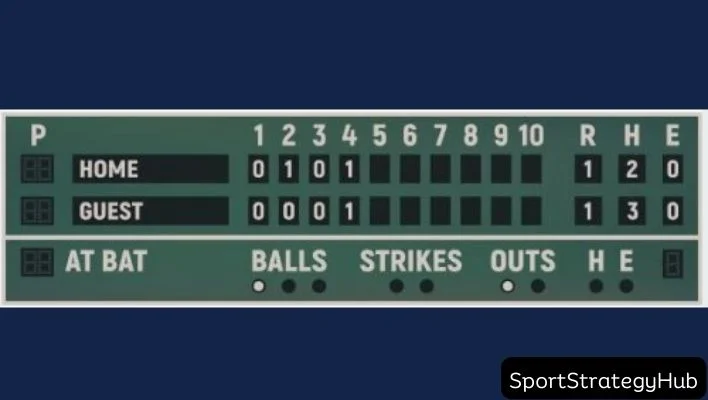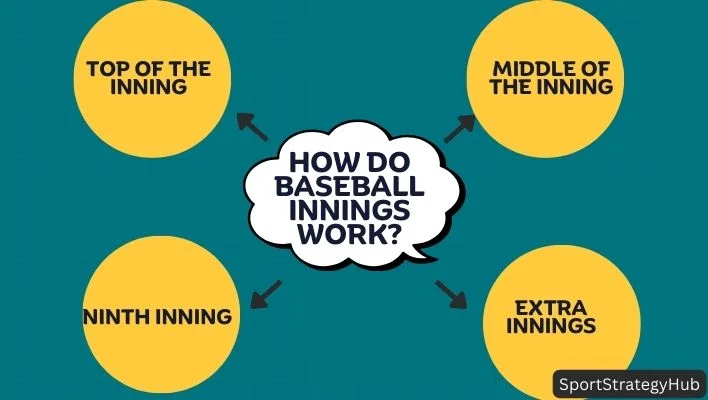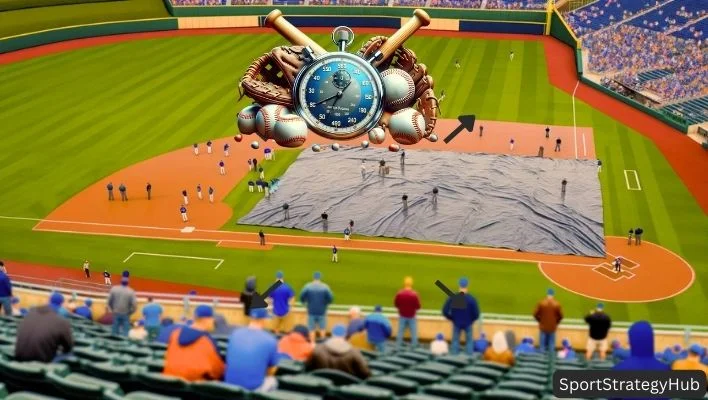How Do Innings Work in Baseball: What Are Innings in Baseball?
How do innings work in baseball?” This question unveils the core structure dividing the game into nine essential segments. Within each inning, teams face off in two halves: the top, with the visiting team aiming for runs, and the bottom, where the home team responds. The objective? Maximize runs before hitting three outs, through strikes, catches, or ground stops. As each side takes their turn, strategy deepens. Post the ninth, a tie leads to extra innings, extending the thrill. But innings offer more than just a game’s rhythm; they’re a strategic battleground, shaping baseball’s soul. What secrets do they hold? Let’s explore the surprising twists innings introduce to the game.
What Are Innings in Baseball?
Before Jumping into ‘how do innings work in baseball, its important to know the basics of inning. In baseball, innings are the parts that make up a regular game. In Major League Baseball (MLB), as well as most professional and amateur baseball leagues, a game consists of nine innings. Each inning provides an opportunity for both teams to score runs and showcase their skills on the field. It’s worth mentioning, however, that if the game is still tied after nine innings. Extra innings can be played until one team wins.
Structure of an Inning
Baseball innings work according to a structure. An inning is split into two parts called the top and bottom of the inning. In the top half, the away team takes the field, assuming the role of the batting team. The home team assumes the role of the fielding team. The team at bat aims to score runs by hitting the ball and running around the bases. Meanwhile, the fielding team tries to prevent them from scoring.

Once the top half of the inning ends with three outs, the teams swap positions. The fielding team moves to the batting position, known as the bottom half of the inning. Meanwhile, the batting team transitions to the fielding position. This back-and-forth rotation continues until both teams have completed their turn at bat and in the field. This totals up to nine innings.
How Do Innings Work in Baseball?

Top of the Inning
The top half of an inning signals the start of the game’s activity. It is the away team’s chance to showcase their offensive prowess and attempt to score runs. The away team’s leadoff hitter steps up to the plate, ready to face the pitcher’s delivery. The objective is to hit the ball into play and reach base safely. This allows subsequent hitters to potentially drive them home and score runs.
During the top half of the inning, the fielding team must demonstrate their defensive skills. They aim to record three outs and prevent the away team from scoring. Fielders strategically position themselves, anticipating hits, catches, and throws to make decisive plays. Once the fielding team achieves three outs, the top half of the inning concludes, and the teams switch positions.
Middle of the Inning
The middle of the inning acts as a break between the top and bottom halves. During this time, players on both teams prepare for their respective roles in the upcoming half of the inning. Batters may take the opportunity to adjust their equipment, such as gloves and helmets. Meanwhile, fielders gather their gear and mentally prepare for their defensive responsibilities.
In professional baseball, locally-televised games typically have a middle inning break of two minutes and 25 seconds. However, nationally-televised games allow for two minutes and 45 seconds. This break allows players to regroup, ensuring a smooth transition between the top and bottom halves of the inning.
Bottom of the Inning
The bottom half of the inning is the home team’s chance to showcase their offensive skills. Here, they attempt to score runs. With the home-field advantage, the home team has the last opportunity to score before the game concludes. The batting order resumes from where it left off in the previous half of the inning. The next hitter steps up to the plate.
Similarly to the top half, the fielding team strives to record three outs and prevent the home team from scoring. They strategically position themselves, aiming to catch fly balls, make accurate throws, and execute defensive plays with precision. Once the fielding team achieves three outs, the bottom half of the inning concludes, and the teams switch positions once again.
Ninth Inning
Many people often view the ninth inning as the most crucial and exciting part of a baseball game. It’s the last chance for both teams to make a big difference in the score. The home team has a potential advantage, as they could win the game in the bottom of the ninth inning.
The ninth inning can end in various ways, such as:
- If the home team is ahead at the end of the top half of the ninth inning, the game finishes without playing the bottom half.
- If the home team ties or falls behind after the top half of the ninth inning, but then scores enough runs to take the lead in the bottom half before making three outs, they win the game.
- If the visiting team is winning at the end of the ninth inning after the home team has completed their three outs, they win the game.
Extra Innings
If the game remains tied after nine innings, the players will play additional innings to determine the winner. Unlike other sports that use sudden death overtime, baseball provides both teams with an opportunity to bat in their respective half-innings during extra innings. This makes sure both teams have a good opportunity to score runs and possibly win.
MLB has recently implemented a rule for extra innings, where a runner begins on second base at the start of each half-inning. This is to help teams score more runs and finish the game faster. Long extra-inning games can make players tired and affect schedules, so this rule helps to avoid that.
Rainouts
Weather conditions can sometimes disrupt the flow of a baseball game. In the last few years, MLB made a new rule for extra innings. Now, a player starts on second base at the beginning of each half-inning. They did this to try to make more runs happen and to end the game faster. Sometimes, long extra-inning games can make players tired and mess up the schedule, so they want to avoid that.
However, once a game reaches the fifth inning or beyond and one team is leading, it attains the status of an official game. In such cases, if weather conditions halt the game, officials will not replay it as long as one team maintains a lead.
Youth League Innings
Youth baseball leagues often have variations in the number of innings played compared to professional baseball.
Typically, youth league games play six innings or adhere to a specific duration of time. Coaches make these adaptations to accommodate the needs and attention spans of young players, ensuring an enjoyable and manageable game length.
Additionally, many youth leagues have “mercy rules” in place. These rules state that if a team establishes a substantial lead by a certain number of runs, such as ten, during the middle of the game, they automatically win, eliminating the need to play the remaining innings.
How Many Innings Are There in a Game?
Apart from ‘How Do Innings Work in Baseball’ Its also quite important to know the number of innings in game. Professional baseball teams play a total of nine innings in a regulation game. This rule makes sure the game is fair for both teams, giving them plenty of chances to show their skills and plan their moves. However, it’s important to note that certain leagues or tournament formats may have different inning requirements or variations based on specific rules and regulations.
How Long Does a Baseball Inning Last?
You have learned ‘how do innings work in baseball`, now its important to know the duration of inning. The duration of an inning can vary depending on multiple factors, including the gameplay itself and external influences. Usually, an inning in professional baseball takes about 20 minutes on average. However, this estimate can fluctuate based on various elements such as the number of runs scored, pitching changes, defensive plays, and timeouts.
It’s important to consider that the duration of an inning is not solely determined by the clock, as baseball games are not restricted by time limits like many other sports. Instead, specific actions, such as recording three outs for each team in an inning, determine the progression of the game.
Do All Baseball Games Go to 9 Innings?
Professional baseball games usually have nine innings, but there can be exceptions to this rule. Certain circumstances can lead to games being shortened or extended beyond the typical nine innings.
One example is a shortened game, often referred to as a “rain-shortened game.” If weather conditions or other unforeseen circumstances, such as power outages, prevent a game from reaching the fifth inning, officials may consider it a complete game even if fewer than nine innings are played.
On the flip side, when a game is tied after nine innings, they keep playing extra innings until someone wins. This gives both teams a fair chance to win and makes sure the game ends with a clear winner.
Where Did the Idea of 9 Innings Come From?
The idea of nine innings in baseball has a long history that goes back to when the game first started. The traditional game length of nine innings is believed to have been established in the mid-19th century by early baseball pioneers. This structure provided a balanced and comprehensive format for teams to compete, allowing for strategic gameplay and a fair outcome.
The decision to settle on nine innings was likely influenced by various factors, including the practicality of game length, player endurance, and the desire to maintain a sense of symmetry in the sport. Over time, the nine-inning format became widely accepted and adopted as the standard for baseball games.
What Adds to the Time of Baseball Games?
Several factors can contribute to the overall duration of a baseball game, extending beyond the innings themselves. These factors include, but are not restricted to:
- Pitcher-Batter Duels: Intense battles between pitchers and batters, involving multiple pitches, can prolong the duration of an inning. Each pitch adds to the excitement and strategic maneuvering, sometimes resulting in extended plate appearances.
- Pitching Changes: When a team decides to substitute their pitcher, it often involves a brief pause in the game. The incoming pitcher requires time to warm up and prepare for their role, leading to a temporary halt in the action.
- Offensive Strategy: Teams may employ various offensive tactics, such as stealing bases, bunting, or engaging in a high-volume of pitch selection. These strategic moves can prolong the duration of an inning, as they require additional time for execution and evaluation.
- Defensive Plays: Exceptional defensive plays, including diving catches, intricate double plays, or precise throws, can prolong the duration of an inning. These moments of defensive brilliance often captivate fans and add excitement to the game.
- Umpire Conferences: In certain situations, umpires may gather to discuss and make crucial decisions regarding plays, rule interpretations, or challenges. These conferences momentarily pause the game, allowing for a fair and accurate outcome.
What Else Impacts Game Length?

While innings directly impact the duration of a baseball game, several other elements can influence the overall length of a game. These factors contribute to the comprehensive understanding of the game’s duration:
- Commercial Breaks: During televised baseball games, there are usually breaks for commercials between innings and when there’s a change in pitchers. These breaks give broadcasters time to show advertisements, which makes the game longer.
- Instant Replay Reviews: In recent years, the introduction of instant replay in baseball has added an additional layer of review and scrutiny to certain plays. Reviewing close calls through the replay system can lengthen the game, as umpires and officials ensure the correct decision is made.
- Timeouts and Conferences: Coaches and players may request timeouts or gather for conferences to discuss strategies, assess performance, or provide instructions. These pauses, while valuable for in-game adjustments, can slightly extend the duration of a baseball game.
- Game Situation Complexity: The intensity and significance of certain game situations, such as close scoring margins or critical points in the game, can lead to increased deliberation, longer at-bats, and more meticulous decision-making. These factors affect how long the game lasts.
FAQ
The seventh-inning stretch is a popular tradition in baseball. During this time, fans stand up and often sing “Take Me Out to the Ballgame.” It provides a brief intermission during the game and allows fans to stretch their legs and rejuvenate before the final innings.
For a Major League Baseball (MLB) game to be official and count in the standings, it needs to last at least five full innings. If a game is called off due to weather conditions or other circumstances before the completion of five innings, it is considered a “no game” and is rescheduled.
If a baseball game is tied after nine innings, they continue playing extra innings until a winner is determined. Each extra inning provides both teams with the opportunity to score runs and secure a victory.
An inning in baseball ends when the fielding team gets three outs. Outs can be achieved through various means, such as catching a fly ball, striking out a batter, or forcing a runner out by touching a base before they reach it.
In the top half of an inning, the away team bats, trying to score runs. The fielding team’s goal is to make three outs and stop the away team from scoring. In the bottom half of the inning, the home team assumes the batting position, while the away team takes the field and strives to prevent runs.
Conclusion
In conclusion, understanding how innings work is essential to comprehending the flow and structure of a baseball game. The game’s progression from the top to the bottom of each inning, the significance of the ninth inning, and the potential for extra innings all contribute to the excitement and drama that make baseball a beloved sport. Next time you watch a game, focus on the innings and enjoy the strategic moves and skilled plays that happen. Join us in exploring the world of baseball and discover the intricacies of how innings shape the game. And If you any quairy regarding ‘how do innings work in baseball’ you can ask in comments section.
